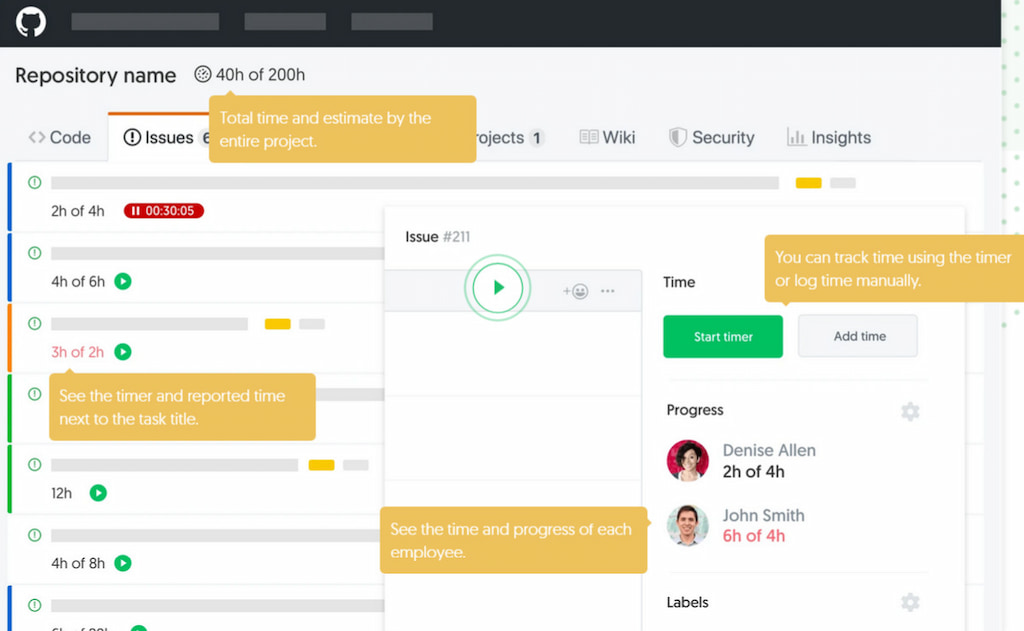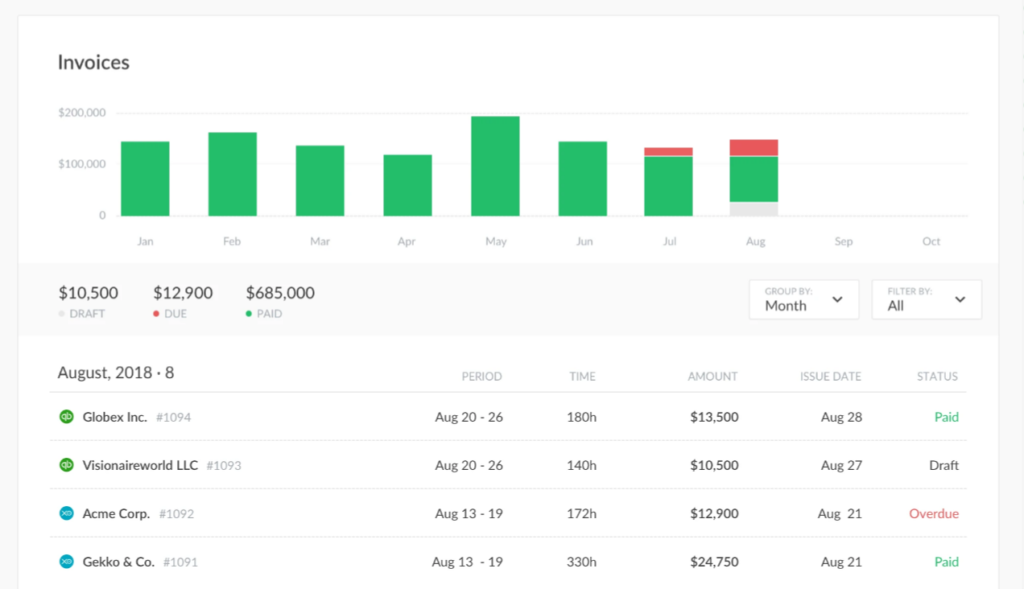Your team has a clean coding standard, helpful pull request checklists, and a README that answers 90% of new contributor questions. The problem? Every new repository starts from zero and drifts as different devs copy-paste last week’s files. One sprint later, you’re reviewing three different PR formats and five slightly different CONTRIBUTING files. Sound familiar? This guide shows you how to fix that once and for all with GitHub templates. You’ll learn what each template type is for (issue, pull request, repository, Actions, Pages, README), how to set them up in minutes, and how to keep them consistent across your organization. We’ll also show where Everhour—GitHub time tracking and GitHub for project management built for project-based teams—slots in so you can estimate and report time directly from issues and pull requests without juggling extra tools.
What GitHub Templates Are (And Why They Matter)
“GitHub templates” is an umbrella for multiple building blocks that standardize how work starts and flows:
- Repository templates: A base repository you can clone as a new starting point, complete with structure, files, and settings.
- Issue templates: Pre-filled forms that contributors pick when they create an issue (bug, feature request, docs, etc.).
- Pull request templates: A default body (or multiple options) for every PR, with checklists and review prompts.
- GitHub Actions workflow templates: Reusable CI/CD workflows (or composite/reusable actions) you can apply to new repos.
- Pages templates: Ready-to-ship website themes and scaffolds for GitHub Pages so docs and sites are consistent.
- README file templates: Structured patterns to make each repo’s front door welcoming and predictable.
- Community health files: CONTRIBUTING, CODE_OF_CONDUCT, SECURITY, FUNDING, etc. (often centralized in a .github repository and applied org-wide).
💡 Why they matter: templates turn “vibes and tribal knowledge” into predictable, repeatable operations. The result is fewer questions, faster reviews, tighter security compliance, and contributor experiences that actually scale.
The Template Landscape at a Glance
Use this quick map to pick the right template type for the job.
| Template type | Lives in | Who benefits | Best for | Notes |
|---|---|---|---|---|
| Repository template | A repo flagged as Template
|
Maintainers, new projects | Bootstrapping services, apps, libraries | Includes folder structure, workflows, labels, CODEOWNERS |
| Issue templates | .github/ISSUE_TEMPLATE |
Maintainers & contributors | Standardizing bug reports & feature requests | Use config.yml to enable chooser and required fields |
| Pull request templates |
.github/pull_request_template.md or .github/PULL_REQUEST_TEMPLATE/
|
Reviewers & authors | Consistent PR descriptions and checklists | Supports a default template or multiple selectable files |
| Actions workflow templates |
.github/workflows or org-level workflow library |
Developers & DevOps | CI/CD: tests, builds, releases, policy enforcement | Prefer reusable workflows and composite actions for reuse |
| Pages templates | In-repo or starter themes / starter repo | Docs teams & maintainers | Documentation sites, product microsites | Use themes or a starter repo for consistent look & deploy |
| README templates | Root README.md (copied from template repo) |
Everyone | Clarity at first glance | Keep top section short; link to deeper docs |
| Community health |
.github repo at org root |
Entire org & contributors | Codes of conduct, security, contributing | Applies by default across org repos (centralized policies) |
Part 1 — Repository Templates: Ship New Repos with Standards Baked In
❓ What they are
A repository you mark as a “Template” and use to generate new repositories. Everything inside—folders, sample code, workflows, labels, branch protection rules (once applied), CODEOWNERS—comes along for the ride.
🤔 Why they’re powerful
- Zero-to-healthy in one click: structure, docs, CI, and labels are already there.
- Guardrails by default: security and review policies aren’t “remembered,” they’re present on day one.
- Fewer bikesheds: decisions (tooling, scripts, folder structure) are made once at the template level.
How to create a repository template
- Create a new repository called template- (for example: template-service-node).
- Add your baseline: README, LICENSE, CODEOWNERS, CONTRIBUTING, SECURITY, .gitignore, docs/, src/, test/, and .github/workflows.
- Turn on “Template repository” in the repository settings.
- Add labels (bug, enhancement, security, good first issue) and protect default branches.
- Document “How to use this template” in the README.
- Click “Use this template” whenever a new project begins.
Governance tip
Create a central “Templates” team that owns the template repos. Use CODEOWNERS to require their review on changes to workflows, security policies, and docs. Version your template with tags and a CHANGELOG so consumers understand what’s new.
Part 2 — GitHub Issue Templates: Clear Intake, Better Triage
❓ What they are
Prebuilt forms for issues stored in .github/ISSUE_TEMPLATE. You can have multiple templates (Bug report, Feature request, Docs improvement, Security disclosure pointer) and a config.yml that shows users a chooser with friendly descriptions.
🤔 Why they’re powerful
- Better signal: reporters include reproduction steps, expected behavior, environment, and acceptance criteria.
- Faster triage: labels, assignees, and projects can be pre-applied from the template.
- Happier contributors: the chooser clearly explains which option to pick.
🔧 How to set them up (quick start)
- Create .github/ISSUE_TEMPLATE/bug_report.yml with fields like “Steps to reproduce,” “Expected,” “Actual,” “Screenshots,” “Environment.”
- Create feature_request.yml for problems to solve, user stories, constraints, and acceptance criteria.
- Add config.yml with contact_links (e.g., “Security issues? See SECURITY.md”) and to show/hide blank issues.
- Optional: add default labels (e.g., type:bug, needs-triage) in each template.
🌟 Good practices
- Ask for minimal reproduction, not essays.
- Provide examples inside placeholders.
- Include a “Definition of done” or acceptance checklist for feature requests.
Part 3 — Pull Request Templates: Reviews That Respect Everyone’s Time
❓ What they are
A default body for PRs (pull_request_template.md) or multiple templates in .github/PULL_REQUEST_TEMPLATE/ that authors can pick from (e.g., refactor, hotfix, feature).
🤔 What to include
- Context and intent: “What problem does this solve?”
- Change type checklist: Feature / Fix / Breaking change / Security.
- Testing notes: How to run tests, screenshots, and performance checks.
- Risk/rollback: Known risks, how to revert if needed.
- References: Related issues, design docs, tickets.
💪 Advanced use
- Multiple PR templates: place files in .github/PULL_REQUEST_TEMPLATE/feature.md, fix.md, chore.md.
- Enforce checklists with protected branches + required status checks (lint/tests).
Part 4 — GitHub Actions Templates: CI/CD on Autopilot
❓ What they are
Starter workflows and reusable actions that standardize build, test, lint, security scanning, and release steps across repositories. Store them in .github/workflows (per repo) or publish a template library within your org.
👍 Patterns that work
- Reusable workflows: centralize common pipelines in a shared repo; call them with workflow_call so teams inherit updates.
- Composite actions: wrap multi-step logic (e.g., setup, cache, lint) into a versioned action used everywhere.
- Environment protections: approvals for deploy to staging/prod; required reviewers separate from code review.
- OIDC for cloud: use OpenID Connect to grant short-lived cloud creds (no long-lived secrets).
- Matrix builds: test across node versions, OSes, or app flavors without copy-paste.
📃 Starter checklist for a healthy pipeline
- On: pull_request and push to main; optional: schedule for nightly checks.
- Jobs: build (install, cache, lint, test), security (SCA/SAST), package (artifacts), release (tag/changelog).
- Concurrency: cancel in-progress runs on new pushes to save minutes.
- Caching: language-specific modules to speed up builds.
- Secrets: managed in org or environment; avoid repo-level sprawl.

Part 5 — GitHub Pages Templates: Beautiful Docs Without Friction
❓ What they are
Prebuilt themes and scaffolds (Jekyll and beyond) for GitHub Pages so you can publish documentation, a marketing site, or a product microsite right from your repo.
🤔 How to get started
- Pick a starter theme (or your custom docs starter repo) with layout, typography, navigation, and search wired up.
- Keep content in docs/ and configure Pages to serve from that folder or the main branch root.
- Add workflows to auto-build and deploy on push.
- For multi-repo orgs: keep a “docs-starter” template repo so every new service ships docs on day one.
📄 Docs UX tips
- Keep the README concise and link to docs/ for depth.
- Use consistent navigation and anchors for predictability.
- Add “Edit this page” links to encourage contributions.
Part 6 — README Templates: Your Repo’s Front Door
The best README files answer five questions within the first screenful:
- What is this? One-sentence value statement.
- Why does it exist? A short “problem → solution” context.
- How do I use it? One-minute quickstart (copy/paste commands).
- How do I contribute? Link to CONTRIBUTING and CODE_OF_CONDUCT.
- Where is everything? “Further reading” to docs/, architecture diagrams, and roadmap.
A solid README template might include: badges (build, coverage), quickstart commands, a configuration table, common tasks, troubleshooting, and a link to SECURITY.md for reporting vulnerabilities. Avoid long walls of text—front-load essentials and move details into docs/.
From Lone Repos to Organization Standards: The .github Repository
Create a top-level .github repository in your org and store:
- ISSUE_TEMPLATE/ and config.yml for shared issue templates.
- PULL_REQUEST_TEMPLATE.md (or folder) for a default PR format.
- CONTRIBUTING.md, CODE_OF_CONDUCT.md, SECURITY.md, SUPPORT.md, FUNDING.yml.
- A default set of workflows (optional) referenced by reusable workflows.
When a repository doesn’t define its own files, GitHub uses the org-level defaults, keeping your contributor experience consistent across every project.
Versioning and Distribution Strategies
- Semantic version your templates (tags like v1.2.0) and keep a CHANGELOG.
- Announce template changes in a #dev-announcements channel and link to diff.
- For repo templates, add a “What changed since I generated my repo?” section to help teams backport updates if needed.
- Consider a “template sync” workflow using actions that open automated PRs to consumers when critical files change (e.g., security scans).
Security and Compliance Considerations
- CODEOWNERS: Require reviews for critical paths (workflows, Dockerfiles, infra).
- Actions pinning: Pin Actions by commit SHA instead of floating @vX to prevent supply chain surprises.
- Secrets hygiene: Prefer environment-level secrets with restricted access; rotate regularly.
- Security.md: Provide clear disclosure instructions and a contact method.
- License clarity: Bake a standard license into templates to avoid ambiguity.
How Everhour Fits into a GitHub-First Workflow
Time tracking should live where work lives: issues, PRs, and projects. Everhour integrates with popular project tools (like Asana, Trello, ClickUp, Notion, and Jira) that many GitHub teams already use for planning, and it can sit alongside GitHub to provide:
- Task-level timers tied to work items: Start/stop tracking from the task you’re actually doing (feature, bug, review).

- Estimates, budgets, and alerts: Add an “Estimated hours” field to your issue templates, track “Actual” with Everhour, and get alerts as you near budget.
- Project/client reporting: Roll up time by repository, label (e.g., “security,” “docs”), milestone, or sprint and export clean reports.
- Invoicing and payroll: Convert approved hours into invoices or sync with accounting; differentiate billable vs internal engineering time.

- Visibility without surveillance: Managers see progress and budget health without invasive monitoring.
Practical example
- 📝 In your issue templates, include fields like “Estimate (hours)” and “Labels.”
- ⏱️ As work begins, start the Everhour timer from your planning tool (or log time manually after a coding session).
- 🔄 On PR, include a “Time spent” section from Everhour and a short summary (what changed, why it matters).
- 📊 Weekly, share a simple report:
“Auth service sprint: 28.5h — new signup flow (12.3h), security patch (6.1h), refactor (10.1h). Remaining budget: 11.5h.” - 💰 At month-end, invoice billable hours with a clean breakdown; keep non-billable maintenance visible for stakeholder transparency.
Tips & Best Practices (Battle-Tested)
- ✂️ Keep templates short but decisive — force the important info, link to details.
- ⚡ Optimize for the happy path — use labels, assignees, and default projects to reduce clicks.
- 📋 Separate “author chores” from “review chores” — in PR templates, use distinct checklists.
- 🤖 Use automation sparingly but smartly — add bots to auto-label, enforce conventions, and nudge missing fields.
- 📝 Show examples — put sample text in placeholders so contributors know the expected tone and depth.
- 🔄 Audit quarterly — retire stale fields, add missing ones, and reflect new security policies.
- 🌍 Localize when it helps — for global communities, consider translated templates or clear language guidance.
- 📊 Measure friction — if contributors circumvent templates, they’re too long or unclear; trim ruthlessly.
A Clean Starter Set You Can Copy
Repository template essentials
- Root: README.md, LICENSE, .gitignore (from official github/gitignore), CODEOWNERS, CONTRIBUTING.md, SECURITY.md
- Folders: src/, test/, docs/ (with an index and architecture overview), .github/workflows/ (build, test, scan)
- Labels: bug, enhancement, documentation, good first issue, security, needs triage
- Branch protections: required reviews, status checks, linear history (optional), signed commits (optional)
Issue templates (chooser)
- Bug report: reproduction, expected vs actual, logs/screenshots, environment/version, impact
- Feature request: problem statement, user story, acceptance criteria, alternatives, risks
- Docs improvement: page link, current behavior, proposed change, screenshots
- Config.yml: contact_links to SECURITY.md and Discussions; disable blank issues if needed
Pull request templates
- Sections: context, changes, tests, risks/rollback, checklist (docs updated, migrations noted), related issues
- Variants: feature.md, fix.md, chore.md for targeted prompts
Actions templates
- Reusable workflows: ci.yml, release.yml, container-scan.yml, dependency-review.yml
- Composite actions: setup-project (cache, install, lint), verify-commit (conventional commits), changelog-generate
Pages template
- docs-starter: default nav, search, syntax highlighting, callouts, CI to build/deploy on push
README template
- One-liner value, supported platforms, quickstart, configuration table, common tasks, troubleshooting, links to docs, and security policy
FAQ: GitHub Templates in Practice
What’s the difference between a template repository and forking?
Forking keeps a link to the source repo and is meant for contributing back. A template repository creates a brand-new repo with the same initial content but no fork relationship—ideal for starting fresh projects with the same baseline.
Can I have multiple issue templates and let users choose?
Yes. Store them in .github/ISSUE_TEMPLATE and add a config.yml to enable the template chooser with descriptive names and about fields.
Can I have multiple pull request templates?
Yes. Place multiple files in .github/PULL_REQUEST_TEMPLATE/. Authors can pick via query parameters or UI options; you can also keep a default template at .github/pull_request_template.md.
Can org-wide templates apply automatically?
Community health files in a top-level .github repo apply to repos that don’t have their own copies. For workflows and more advanced defaults, use reusable workflows or a repo template.
How do I keep templates up to date across many repos?
Version your templates and announce changes. Consider a bot or workflow that opens PRs to consumer repos when critical files change (e.g., workflow pins, security scans).
Do I need to use Jekyll for GitHub Pages templates?
No. Jekyll is the classic path, but you can also publish static sites built with other generators; use Actions to build and push to Pages.
Should I pin GitHub Actions versions?
Yes—pin by commit SHA where possible for supply chain safety. Avoid floating tags like @v1 unless you trust the publisher and accept the risk.
How does Everhour help if we already use GitHub Projects?
Keep GitHub for code and planning. Use Everhour for estimates, actuals, budgets, and clean exports. It reduces manual math, helps forecast capacity, and turns issue/PR work into client-friendly reports and invoices when needed.
Final Thoughts
Templates are how great teams scale quality. They encode your best decisions once, then apply them every time a developer files an issue, opens a PR, starts a workflow run, or creates a new repository. That consistency pays dividends: cleaner reviews, fewer regressions, tighter security, happier contributors.
Your next three moves:
- Stand up an org-level .github repository and a single “golden” repository template this week. Keep the first pass minimal—then iterate.
- Add an issue template chooser and a PR template with a short, focused checklist. You’ll feel the review quality jump immediately.
- Wire up reusable Actions workflows and a docs starter for GitHub Pages so every repo ships with CI and docs from day one.
And when you’re ready to connect effort to budgets and outcomes, bring Everhour into the mix. Estimate time in your issue templates, track without context switching, and share simple reports that keep stakeholders aligned—no spreadsheets, no guesswork.
🔎 Check out real reviews from users about Everhour:
“Since we started using Everhour we began to understand the time involved in our project, not the estimated time but the ACTUAL time, which is a lot, because now we know when the fee is not adjusted to the real dedication. It also helped every team member to understand how to make their shifts more efficient.” [María Lucía S., Capterra]
“I liked how I could quickly log hours directly from my project management tool, ensuring accurate time reports for all my tasks.” [Manon, Capterra]
“Everhour has made my life so much easier when it comes to tracking time and managing projects. The reporting capabilities are awesome. I can easily see where I am spending time and adjust if necessary.” [Daniel, G2]
Learn how GitHub personal access tokens can enhance your security and workflow inside GitHub in no time!

